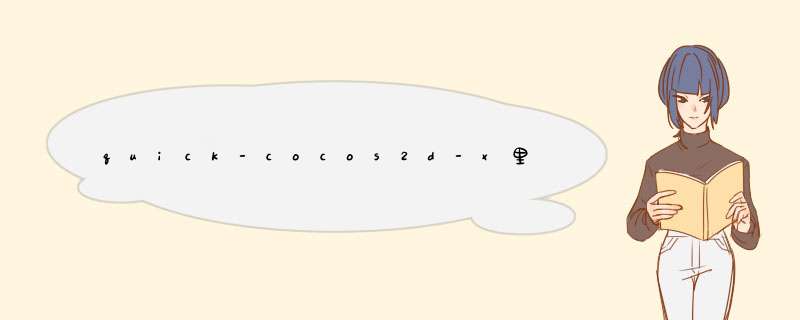
标题有点大。内容有点水哈。最近app上架,空闲时间比较多,于是开始重构代码。发现重构是件很好玩的事情,可以把以前看过的设计模式实验一番。可惜水平有点浅,所以高手就回避吧。
看过一本书,叫《cocos2d-x高级开发教程-制作自己的捕鱼达人》。里面有个观点是,scene应该是MVC里面的control层。后来想了想还是挺有道理的,这几天就实践了一把。其实cocos2d-x有自己的图形界面工具,但是实际的做法很简单,我也懒得去学(也可能是我闭门造车哈)。quick里面的MVC 还是很简单的,scene来处理业务逻辑,UI可以用数据驱动。
首先将生成UI的数据写到lua table中,格式如下:
local firstLogin = { class = "CCNode",name = "root",childrens = { { name = "loginMenu",class = "Ccmenu",items = { {name = "loginBg",class = "ImageMenuItem",options = { image = {class = "CCSprite9Scale",file = "res/ui030_1_2.png",size = CCSize(275,75)},imageSelected = {class = "CCSprite9Scale",file = "res/ui030_1_8.png",tag = 11,pos = CCPoint(172,display.height - 408) } },{name = "registBg",tag = 13,pos = CCPoint(467,},tag = 1112 },{ name="label1",,options={text="登录",size=30,color=ccc3(255,255,255)},pivot="center",x=172,y=display.height - 410,tag=10 } },tag = 44}return firstLogin当然,你也可以不用这么写,毕竟不用cocos2d自带的UI生成工具就是为了发挥自主性,只要你觉得容易解析,数据格式怎么定义都无所谓。 然后去解析数据,这里用了一下工厂模式,将数据传入工厂,工厂负责解析数据,最后交由具体的车间去生产。由于层级不是固定的,存在子结点与父结点的关系。所以工厂最后用递归来写一下。生成结点代码如下(这里要注意一下,child:addTo(parent)根据tag是检索不到child的,要用tag检索就要使用parent:addChild())。
function NodeInflater:inflate_luatable(param,parentNode) local rootNode = param -- 创建自己 local node = self:createNodeFromTag(rootNode.class,rootNode) -- 孩子 self:rInflate(rootNode,node) -- 加到父节点上去 parentNode:addChild(node) return nodeend
至于车间怎么设计,看个人爱好了。我是这么做的
function NodeFactory:onCreateNode(JsonNode) local uiNode local classname = JsonNode.class -- 判断控件的类型 if "UIImage" == classname then -- sprite uiNode = self:onCreateNode_UIImage(JsonNode) elseif "CCNode" == classname then -- node uiNode = self:onCreateNode_CCNode(JsonNode) elseif "UIPushbutton" == classname then -- UIPushbutton uiNode = self:onCreateNode_UIPushbutton(JsonNode) elseif "UILabel" == classname then -- label uiNode = self:onCreateNode_UILabel(JsonNode) elseif "UiSlider" == classname then --slIDer uiNode = self:onCreateNode_UiSlider(JsonNode) elseif "CCProgresstimer" == classname then --progresstimer uiNode = self:onCreateNode_CCProgresstimer(JsonNode) elseif "Ccmenu" == classname then -- Ccmenu uiNode = self:onCreateNode_Ccmenu(JsonNode) elseif "CCSprite" == classname then -- CCSprite uiNode = self:onCreateNode_CCSprite(JsonNode) elseif "CCSprite9Scale" == classname then uiNode = self:onCreateNode_CCSprite9Scale(JsonNode) end -- 应用 self:applyNodeAttributesByJsonNode(uiNode,JsonNode) return uiNodeend
这里注意一下,为了在scene中检索到具体的子结点,既可以将每个结点的索引存到父节点的table中(在quick中一切数据结构皆为table),也可以用tag进行检索,我这里采用的是使用tag进行检索。
最后是在scene中生成UI并添加逻辑(以menu为例),
local function loginSelected(tag)end -- 生成first login local filename = "app.data.FirstLoginData" require("app.Utils.NodeInflater"):easyRootInflater():inflate(filename,layer) -- 为menu添加触摸事件 local menuItems = layer:getChildByTag(44):getChildByTag(1112):getChildren() for i=1,menuItems:count() do menuItems:objectAtIndex(i-1):registerScriptTapHandler(loginSelected) end 这样子就可以完成UI,与逻辑分离了。水平有限,是在抱歉。 总结 以上是内存溢出为你收集整理的quick-cocos2d-x里的MVC全部内容,希望文章能够帮你解决quick-cocos2d-x里的MVC所遇到的程序开发问题。
如果觉得内存溢出网站内容还不错,欢迎将内存溢出网站推荐给程序员好友。
欢迎分享,转载请注明来源:内存溢出

 微信扫一扫
微信扫一扫
 支付宝扫一扫
支付宝扫一扫
评论列表(0条)